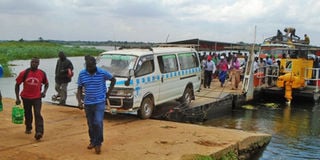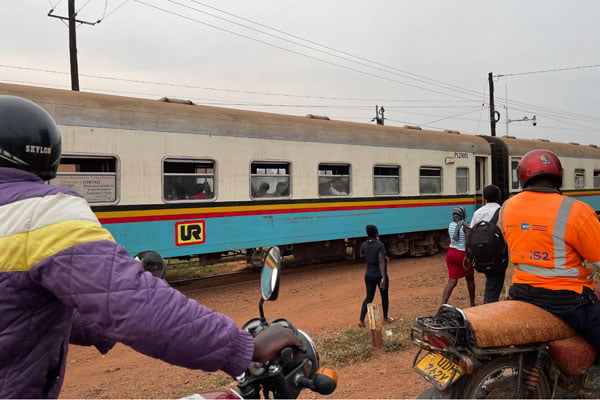Kayunga-Kamuli ferry spurs trade

Spurring development. Passengers and motorists disembark from the Kayunga-Kamuli ferry last Friday. The ferry has boosted trade between the two districts. PHOTO BY FRED MUZAALE
What you need to know:
- According to Mr Mark Ssali, the Uganda National Roads Authority (Unra) spokesperson, the ferry carries an average of 700 passengers and about 65 vehicles a day.
KAYUNGA. Mr Sam Kitaka, drives a lorry loaded with sugarcane onto a ferry that links Kayunga and Kamuli district across River Nile at Kasana Landing Site in Busaana Sub-county, Kayunga District.
On a Friday afternoon, Kitaka’s truck is one of the six vehicles carrying merchandise that the ferry conveys across the river from Kayunga to Kamuli districts.
Kitaka says the ferry services have helped him cut the costs of transporting produce to Mayuge sugar factory in Mayuge District.
“Before the ferry was introduced, I used to take a longer route to Kayunga-Njeru through Jinja then to Mayuge, which was expensive for me, but now when I cross from here, I cut the fuel cost by half,” Mr Kitaka, who is also a sugarcane farmer in Kyayaye Village in Busaana sub-county, testifies.
The Shs3b ferry was commissioned in 2013, nearly 30 years after the previous one was decommissioned.
The ferry acts as a mobile road and its services are free. It takes only 15 minutes for the ferry to move from Kasana Landing Site to Mbulamuti Landing Site in Kamuli District. The ferry carries both passengers and goods and on a daily basis, according to Mr Mark Ssali, the Uganda National Roads Authority (Unra) spokesperson, the ferry carries an average of 700 passengers and about 65 vehicles daily.
The Kayunga District Chairperson, Mr Tom Sserwanga, says the vessel has greatly boosted trade between the two districts and also enhanced the development of Kayunga, Busaana and some other trading centres along Kayunga-Kamuli route.
“Because of reduced transport costs and a shorter alternative route, traders from Kayunga District buy oranges, cattle and chicken from Busoga Sub-region and make some good profit, which was not the case before,” Mr Sserwanga says.
Busoga Sub-region is known for fruit, maize and groundnuts growing while Kayunga is known for pineapple, coffee and banana growing.
He adds that since many travellers from Kampala to Busoga Sub-region, especially those that are enroute to areas such as Kaliro, Kamuli, Buyende and Pallisa now go through Kayunga Town, it has led to establishment of roadside markets such as at Amanyi Ababe in Kiwangula village, Busaana Sub-county.
About 20 people who sell foodstuffs have now got employment in this daily market.
“Because Kayunga Town had no highway that goes through it, development had stagnated, but now the ferry has created a highway of sorts through the district, which has given a boost to hotels, lodges and tourism,” the district chairperson says.
Busaana Sub-county chairperson, Mr David Mubialiwo, says the ferry has increased their tax base as they get revenue from people who sell foodstuffs, chicken and juice among other merchandise at the landing site. Mr Ssali says he is happy that residents are enjoying the benefits that have come with the introduction of the ferry.
“Automatically when people spend little on transport they can make savings which they can use to invest, hence poverty reduction,” Mr Ssali says.
The Ntenjeru North Member of Parliament, Mr Amos Lugolobi, advises residents to optimally utilise the water vessel to fight poverty in their households by growing high value crops and investing in service sectors such as hotels and tourism.
Mr Henry Wasswa, a pineapple trader in Kangulumira, says he used to sell his produce in Kampala but when the ferry services were introduced he switched to Kamuli and Iganga, where he says he gets more profits than in the city.




